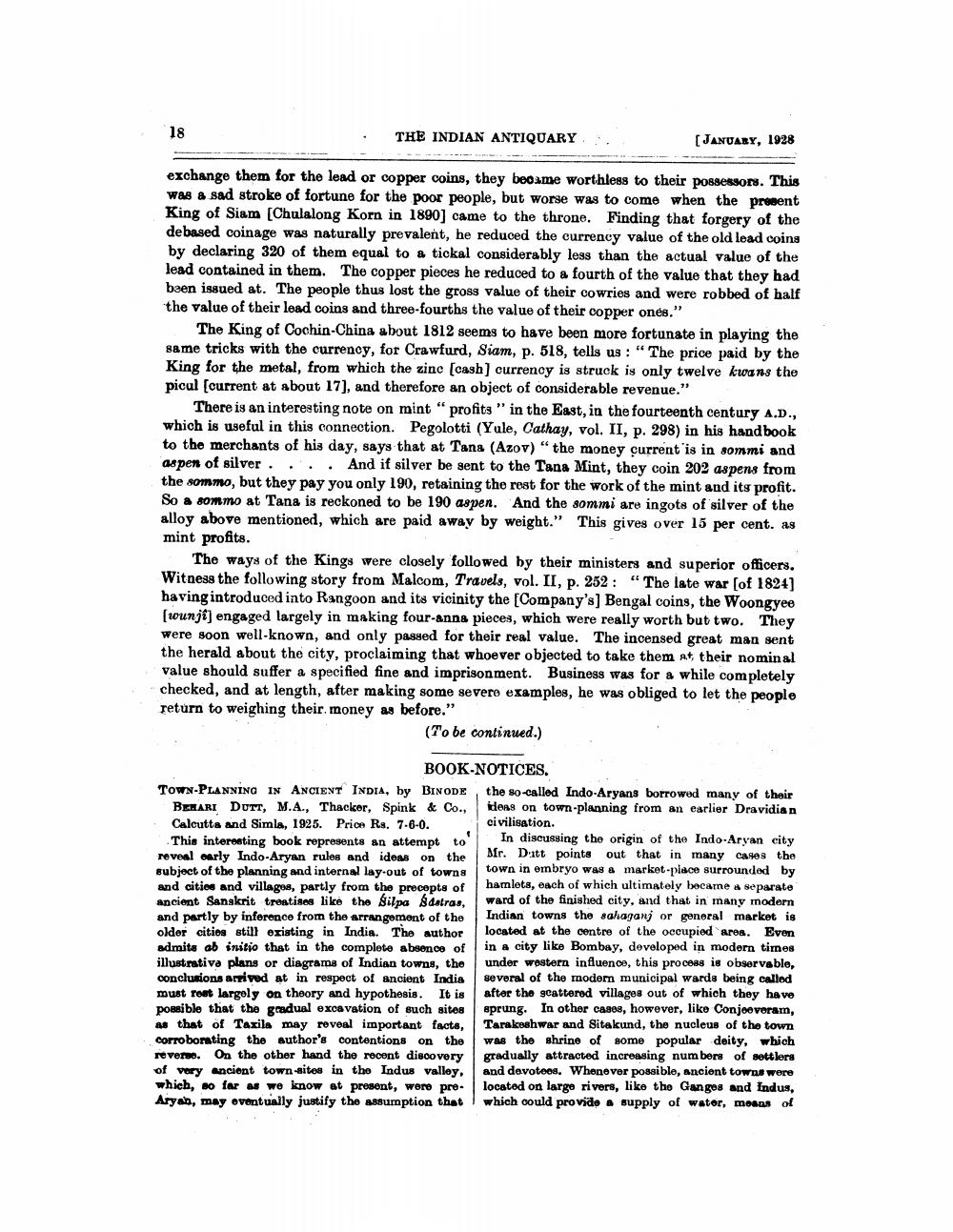________________
18
THE INDIAN ANTIQUARY
[JANUARY, 1928
exchange them for the lead or copper coins, they broame worthless to their possessors. This was a sad stroke of fortune for the poor people, but worse was to come when the present King of Siam [Chulalong Korn in 1890] came to the throne. Finding that forgery of the de based coinage was naturally prevalent, he reduced the currency value of the old lead coins by declaring 320 of them equal to a tickal considerably less than the actual value of the lead contained in them. The copper pieces he reduced to a fourth of the value that they had been issued at. The people thus lost the gross value of their cowries and were robbed of half the value of their lead coins and three-fourths the value of their copper ones."
The King of Cochin-China about 1812 seems to have been more fortunate in playing the same tricks with the currency, for Crawfurd, Siam, p. 518, tells us : "The price paid by the King for the metal, from which the zinc (cash) currency is struck is only twelve kwans the pical (current at about 17), and therefore an object of considerable revenue."
There is an interesting note on mint "profits " in the East, in the fourteenth century A.D., which is useful in this connection. Pegolotti (Yule, Cathay, vol. II, p. 298) in his handbook to the merchants of his day, says that at Tana (Azov) “the money current'is in sommi and aspen of silver .... And if silver be sent to the Tana Mint, they coin 202 aspens from the sommo, but they pay you only 190, retaining the rest for the work of the mint and its profit. So a sommo at Tana is reckoned to be 190 aspen. And the sommi are ingots of silver of the alloy above mentioned, which are paid away by weight." This gives over 15 per cent. as mint profits.
The ways of the Kings were closely followed by their ministers and superior officers. Witness the following story from Malcom, Travels, vol. II, p. 252: “The late war (of 1824) having introduced into Rangoon and its vicinity the Company's] Bengal coins, the Woongyee (wunji) engaged largely in making four-anns pieces, which were really worth but two. They were soon well-known, and only passed for their real value. The incensed great man sent the herald about the city, proclaiming that whoever objected to take them at their nominal value should suffer a specified fine and imprisonment. Business was for a while completely checked, and at length, after making some severe examples, he was obliged to let the people return to weighing their money as before."
(To be continued.)
BOOK-NOTICES. Town-PLANNING IN ANCIENT INDIA, by BINODE, the so-called Indo-Aryans borrowed many of their
BEHARI DUTT, M.A., Thacker, Spink & Co., deas on town-planning from an earlier Dravidian Calcutta and Simla, 1925. Price Rs. 7.6-0.
civilisation. This interesting book represents an attempt to
In discussing the origin of the Indo-Aryan city reveal early Indo-Aryan rules and ideas on the
Mr. Datt points out that in many cases the subject of the planning and internal lay out of towns
town in embryo was a market place surrounded by and cities and villagoa, partly from the precepts of
hamlets, each of which ultimately became a separate ancient Sanskrit treatises like the Silpa Sdatras, ward of the finished city, and that in many modern and partly by inference from the arrangement of the Indian towns the sahajanj or general market is oldor cities still existing in India. The author
located at the centre of the occupied ares. Even admits ab initio that in the complete absence of
in a city like Bombay, developed in modern times illustrativa plans or diagrams of Indian towns, the under western influence, this process is observable, conclusions arrived at in respect of ancient India several of the modern municipal wards being called must reat largely on theory and hypothesis. It is after the scattered villages out of which they have possible that the gradual excavation of such sites sprung. In other ca888, however, like Conjoevoram, as that of Taxila may reveal important facte, Tarakeshwar and Sitakund, the nucleus of the town corroborating the author's contentions on the was the shrine of some popular deity, which reverso. On the other hand the recent discovery gradually attracted increasing numbers of settlers of very ancient town sites in the Indus valley, and devotees. Whenever possible, ancient towns were which, so far as we know at present, were pre- located on large rivers, like the Ganges and Indus, Aryan, may oventually justify the assumption that which could provide a supply of water, mosas ol




